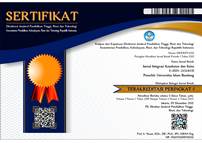Efek Antidislipidemia Fraksi Jahe Gajah pada Mencit Model Sindrom Metabolik
Abstract
Sindrom metabolik merupakan istilah yang menggambarkan keadaan kombinasi klinis, yaitu hipertensi, hiperglikemia, dislipidemia, dan obesitas. Dislipidemia adalah keadaan metabolisme lipid pada tubuh terganggu. Kandungan flavonoid dalam jahe gajah dapat memengaruhi profil lipid dalam tubuh. Tujuan penelitian ini menganalisis pengaruh fraksi etil asetat jahe gajah terhadap kadar HDL dan LDL pada mencit model sindrom metabolik. Penelitian ini adalah penelitian eksperimental laboratorik dengan 20 ekor mencit jantan tua (36–40 minggu) Penelitian dilaksanakan di Laboratorium Farmasi Institut Teknologi Bandung (ITB) dan Laboratorium Patologi Klinik RSUD Cicalengka. bulan Maret-Mei 2019. Mencit dibagi menjadi 4 kelompok. Semua kelompok diberikan pakan tinggi lemak selama 28 hari. Kelompok kontrol tanpa diberi fraksi jahe, kelompok perlakuan 1 fraksi etil asetat jahe gajah 0,78 mg/kg bobot/hari, kelompok perlakuan 2 diberikan fraksi etil asetat jahe gajah 1,56 mg/kg bobot/hari, dan kelompok perlakuan 3 diberikan fraksi etil asetat jahe gajah 3,12 mg/kg bobot/hari. Rerata kadar HDL kelompok perlakuan cenderung meningkat, sedangkan rerata kadar LDL kelompok perlakuan ada kecenderungan menurun. Analisis statistik dengan one-way ANOVA, baik kadar HDL dan LDL menunjukkan hasil tidak signifikan (p HDL=0,190) dan (p LDL=0,300). Koefisien korelasi dengan Uji Pearson konsentrasi fraksi jahe gajah dengan kadar HDL dan LDL memiliki hubungan yang rendah, tetapi pasti (r=0,23). Simpulan, fraksi etil asetat jahe gajah memengaruhi kadar HDL dan LDL.
ANTI DYSLIPIDEMIA EFFECT OF GINGER FRACTION IN METABOLIC SYNDROME MICE MODELS
Metabolic syndrome is a term that describes the clinical combination of hypertension, hyperglycemia, dyslipidemia and obesity. Dyslipidemia is a state of disruption of lipid metabolism in the body. The flavonoids in elephant ginger can affect the lipid profile in the body. The purpose of this study was to analyze the effect of ginger elephant ethyl acetate fraction on HDL and LDL levels in metabolic syndrome mice models. Laboratory experimental study with 20 old male mice (36–40 weeks) The study was held in Laboratorium Farmasi Institut Teknologi Bandung (ITB) and Laboratorium Patologi Klinik RSUD Cicalengka. during March-May 2019. Mice are divided into 4 groups. All groups were fed a high-fat diet for 28 days. The control group was given no ginger fraction, group 1 was given elephant glycol ethyl acetate 0.78 mg/kgBW/day, treatment group 2 was given elephant glycol ethyl acetate 1.56 mg/kgBW/day, and treatment group 3 was given elephant ginger ethyl acetate fraction 3.12 mg/kgBW/day. The mean HDL level of the treatment group tended to increase, while the mean LDL level of the treatment group there was a downward. Statistical analysis with one-way ANOVA, both HDL and LDL levels showed insignificant results (HDL p value=0.190) and (LDL p value=0.300). The correlation between the concentration of ginger elephant fraction on HDL and LDL levels with Pearson showed small results (r=0.23). In conclusion, the ginger elephant ethyl acetate fraction affected HDL and LDL levels.
Keywords
Full Text:
PDFReferences
Rochlani Y, Pothineni NV, Kovelamudi S. Metabolic syndrome: pathophysiology, management, and modulation by natural compounds. Ther Adv Cardiovasc Dis. 2017 Aug;11(8):215–25.
Bibiloni M del M, Salas R, De la Garza YE, Villarreal JZ, Sureda A, Tur JA. Serum lipid profile, prevalence of dyslipidaemia, and associated risk factors among Northern Mexican adolescents. J Pediatr Gastroenterol Nutr. 2016;63(5):544–9.
Redheuil A, Yu W-C, Mousseaux E, Harouni AA, Kachenoura N, Wu CO, dkk. Age-related changes in aortic arch geometry. J Am Coll Cardiol. 2011;58(12):1262–70.
Golomb BA, Evans MA. Statin adverse effects: a review of the literature and evidence for a mitochondrial mechanism. Am J Cardiovasc Drugs. 2008;8(6):373–418.
Ozougwu JC, Eyo JE, Clarence OK, Soniran O, Kelechukwu DM. Investigationof the antihepatotoxic effects of Allium sativum extracts against acetaminophen intoxicated Rattus novergicus. World J Med Sci. 2014;11(3):397–404.
Kim M-B, Kim C, Song Y, Hwang J-K. Antihyperglycemic and anti-inflammatory effects of standardized Curcuma xanthorrhiza Roxb. Extract and its active compound xanthorrhizol in high-fat diet-induced obese mice. Evid Based Complement Alternat Med. 2014;2014:1–10.
Yulianti AB, Widayanti, Rahmawaty I. Efek proteksi campuran ekstrak bawang putih, jahe gajah, dan lemon terhadap kadar kolesterol total darah pada tikus tua yang terpapar diet tinggi lemak. Prosiding SNaPP. 2017:215–21.
Attari VE, Mahluji S, Jafarabadi MA, Ostadrahimi A. Effects of supplementation with ginger (Zingiber officinale Roscoe) on serum glucose, lipid profile and oxidative stress in obese women: a randomized, placebo-controlled clinical. Pharmaceutical Sci. 2015;21(4):184–91.
Al-noory AS, Amreen A, Hymoor S. Antihyperlipidemic effects of ginger extracts in alloxan-induced diabetes and propylthiouracil-induced hypothyroidism in (rats). Pharmacognosy Res. 2013;5(3):157–62.
Al-Nahain A, Jahan R, Rahmatullah M. Zingiber officinale: a Potential plant against rheumatoid arthritis. Arthritis. 2014;2014:1–8.
Abdul-hussein BA. Study the effect of zingiber officinale extract on the serum lipids in rabbits. J Ethnopharmacol. 2014;3(10):146–9.
Katib SMA, Kalo MS. The antioxidant effects of flavonoids and non flavonoid part extracted from ginger (zingiber officinale) roots. J Raf Sci. 2009;20(3):18–31.
Ningsih IY, Jamu S. Keamanan jamu tradisional. Jember: 2016. [diunduh 11 Mei 2019]. Tersedia dari: https://repository.unej.ac.id/bitstream/handle/123456789/77274/Modul%20SJ%20Keamanan%20Jamu_Indah%20Yulia%20Ningsih.pdf?sequence=1
DOI: https://doi.org/10.29313/jiks.v2i1.4343
Refbacks
- There are currently no refbacks.
Jurnal Integrasi Kesehatan dan Sains is licensed under a Creative Commons Attribution-NonCommercial-ShareAlike 4.0 International License.







.png)
_(1).png)




















